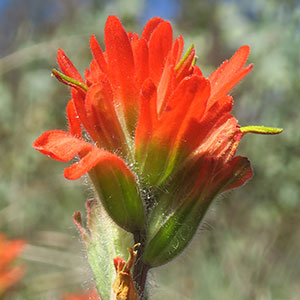Castilleja brevilobata
Castilleja rubicundula
short-lobed paintbrush
cream sacs
solitary or few, erect or ascending, unbranched, sometimes branched, hairs spreading, short, medium, and long, soft, short and medium ones short stipitate-glandular.
solitary, erect, unbranched, sometimes branched, hairs spreading, short, soft, often mixed with stipitate-glandular ones.
green or ± yellow, lanceolate, elliptic, or oblong to narrowly ovate, 1–2(–2.5) cm, not fleshy, margins plane or wavy, involute, (0–)3–5(–7)-lobed, apex rounded to acute;
lobes ascending to erect, linear to lanceolate, apex rounded to acute.
green to purple-tinged or dark red-brown, linear-lanceolate or distal lanceolate, 2–8(–9) cm, not fleshy, margins plane, flat to slightly curved up, 0–7-lobed, apex acute to acuminate;
lobes widely spreading or ascending-spreading, linear, apex acute.
3–20 × 2–3.5 cm;
bracts proximally greenish to dull brown, distally red, orange-red, or scarlet, sometimes orange or yellow, broadly lanceolate or oblong, (0–)3–5-lobed;
lobes ascending, broadly to narrowly lanceolate, short, arising above mid length, apex acute, obtuse, or rounded.
2.5–24 × 3–4 cm;
bracts green throughout, lanceolate to ovate, 5–9-lobed;
lobes ascending, linear-lanceolate or lanceolate, medium length, arising near mid length, apex acute to acuminate.
straight, 15–24(–26) mm;
tube 12–16 mm;
beak exserted, abaxial lip equal to calyx;
beak adaxially green or ± yellow-green, 7–10 mm, puberulent, stipitate-glandular;
abaxial lip deep green, reduced, rounded, 1–2 mm, 10–25% as long as beak;
teeth incurved to erect, light green, 0.5–1 mm.
straight, (15–)20–28 mm;
tube 8–24 mm;
abaxial lip, beak, and proximal part of corolla tube exserted;
beak adaxially white, rarely very pale yellow or pale pink-purple, 5–7 mm, inconspicuously puberulent;
abaxial lip white, fading to pink to pink-purple, or yellow, fading to white, rarely then to pink or pink-purple, both forms often with purple or red dots at base, inflated, prominent, pouches 3, 8–10 mm wide, 4–6 mm deep, 4–6 mm, 80–100% as long as beak;
teeth erect, white or yellow, 0.5 mm.
green or whitish with green veins, lobes colored as bract lobes or paler, 14–30 mm;
abaxial and adaxial clefts 5.5–8.5 mm, 30–40% of calyx length, deeper than laterals, lateral 1.5–4 mm, 20–25% of calyx length;
lobes oblong to narrowly triangular, apex obtuse to rounded.
green, 8–14 mm;
abaxial and adaxial clefts 3–6 mm, 30–50% of calyx length, all 4 clefts subequal;
lobes linear, apex acuminate to acute.
± exserted, as long as or slightly longer than beak and visible from abaxial side.
= 24.
= 24.
Castilleja brevilobata
Castilleja rubicundula
Castilleja brevilobata is endemic to dry serpentine openings in the Siskiyou Mountains of southwestern Oregon and adjacent California. Although sometimes treated as part of C. applegatei or C. hispida, its morphology does not suggest a close connection with either. This species occasionally hybridizes with C. pruinosa in Del Norte County, California.
(Discussion copyrighted by Flora of North America; reprinted with permission.)
Varieties 2 (2 in the flora).
Castilleja rubicundula is separated into two varieties on the basis of flower color, as well as subtle differences in the pouching of the abaxial corolla lip. The ranges of the two varieties are broadly overlapping, but they never grow in the same location. Few intermediate forms have been recorded, though a very unusual population system exists in Santa Clara County, within which virtually all plants exhibit a tricolored corolla sequence, with yellow flowers aging to white and then pink or pink-purple, with all three colors visible on mature inflorescences.
(Discussion copyrighted by Flora of North America; reprinted with permission.)
1. Abaxial lips of corollas white, in most populations quickly fading to pink or pink-purple. | var. rubicundula |
1. Abaxial lips of corollas light to bright yellow, in some populations quickly fading to white, then rarely to pink or pink-purple. | var. lithospermoides |


